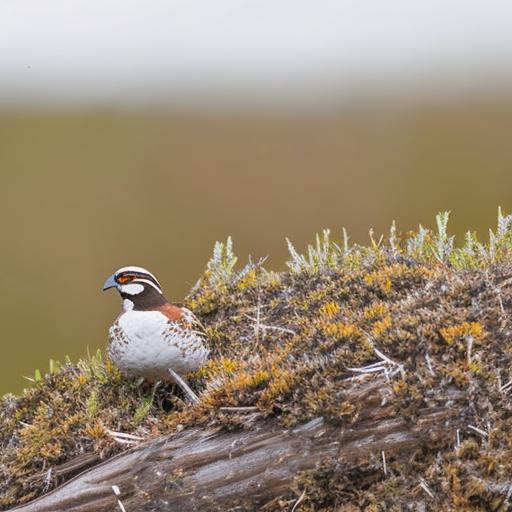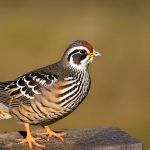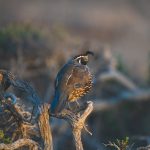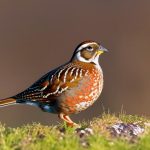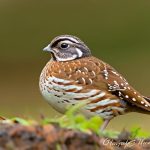Bobwhite quail, also known as northern bobwhite, are small, ground-dwelling birds native to North America. They are popular game birds and are often sought after by hunters for their challenging and exciting hunting experience. Bobwhite quail are known for their distinctive call, which sounds like “bob-white,” and their quick, low flight pattern when flushed from cover.
These birds are typically found in open grasslands, agricultural fields, and brushy areas with scattered shrubs and trees. They are social birds and often form coveys, which are small groups of birds that forage and roost together. Bobwhite quail are primarily seed-eaters, feeding on a variety of grasses, weeds, and seeds found in their natural habitat. They also consume insects and other small invertebrates, especially during the breeding season when they need extra protein for egg production and chick rearing.
Bobwhite quail are known for their adaptability and resilience, but their populations have been declining in recent years due to habitat loss, changes in land use, and predation. Conservation efforts are underway to protect and restore their natural habitat and ensure the long-term survival of these iconic birds.
Key Takeaways
- Bobwhite quail are ground-dwelling birds native to North America, known for their distinctive “bob-white” call.
- Creating the ideal habitat for bobwhite quail involves providing open grasslands, shrubby areas, and water sources.
- Bobwhite quail require a diet high in protein, such as insects and seeds, and may benefit from supplemental feed in captivity.
- Managing predators and pests is crucial for the survival of bobwhite quail, with measures such as predator-proof fencing and regular pest control.
- Breeding and rearing bobwhite quail involves providing proper nesting sites, incubation of eggs, and care for the young chicks.
Creating the Ideal Habitat for Bobwhite Quail
Creating the ideal habitat for bobwhite quail is essential for their survival and population growth. These birds thrive in open grasslands with scattered shrubs and trees, so it’s important to manage the land to provide suitable cover, food, and nesting sites for them. One of the key components of bobwhite quail habitat is the presence of native grasses and forbs, which provide food and cover for the birds. It’s important to maintain a diverse mix of grasses and forbs to ensure a year-round food supply for the quail.
In addition to native vegetation, brushy areas with scattered shrubs and small trees are also important for bobwhite quail habitat. These areas provide cover from predators and nesting sites for the birds. It’s important to manage these areas to prevent them from becoming too dense or overgrown, as this can limit the quail’s ability to move and forage.
Another important aspect of bobwhite quail habitat management is the control of invasive species and woody encroachment. Invasive plants and trees can outcompete native vegetation and reduce the quality of the habitat for bobwhite quail. It’s important to implement control measures to manage these invasive species and promote the growth of native plants that are beneficial to the quail.
Overall, creating the ideal habitat for bobwhite quail requires a combination of land management practices, including prescribed burning, grazing management, and habitat restoration efforts. By providing suitable cover, food, and nesting sites, landowners can help support healthy bobwhite quail populations on their property.
Providing the Right Nutrition for Bobwhite Quail
Providing the right nutrition for bobwhite quail is essential for their overall health and reproductive success. These birds are primarily seed-eaters, but they also consume insects and other small invertebrates as a source of protein. It’s important to provide a balanced diet that meets their nutritional needs throughout the year, especially during the breeding season when they require extra protein for egg production and chick rearing.
One way to provide the right nutrition for bobwhite quail is by managing the habitat to promote the growth of native grasses, forbs, and other plants that are part of their natural diet. By maintaining a diverse mix of vegetation, landowners can ensure that the quail have access to a variety of seeds and insects that make up their diet.
In addition to natural food sources, landowners can also supplement the quail’s diet with specially formulated game bird feed. These feeds are designed to provide a balanced mix of protein, vitamins, and minerals that are essential for the quail’s health and reproduction. Supplemental feeding can be especially beneficial during periods of food scarcity, such as during harsh winters or droughts when natural food sources may be limited.
Overall, providing the right nutrition for bobwhite quail requires a combination of habitat management and supplemental feeding to ensure that the birds have access to a diverse and balanced diet throughout the year. By meeting their nutritional needs, landowners can help support healthy bobwhite quail populations on their property.
Managing Predators and Pests
Managing predators and pests is an important aspect of bobwhite quail conservation and management. These birds face a variety of threats from predators such as foxes, raccoons, snakes, and raptors, as well as pests like ticks and mites that can impact their health and reproductive success. It’s important to implement effective predator and pest management strategies to minimize their impact on bobwhite quail populations.
One way to manage predators is by creating suitable cover for the quail that provides protection from predators. This can be achieved by maintaining brushy areas with scattered shrubs and trees where the quail can seek refuge from predators. Additionally, landowners can implement predator control measures such as trapping or hunting to reduce predator populations in areas where bobwhite quail are present.
In addition to predators, pests such as ticks and mites can also impact bobwhite quail populations. These parasites can cause stress, disease, and reduced reproductive success in quail. It’s important to implement pest management strategies such as habitat manipulation, chemical treatments, or biological control methods to reduce pest populations and minimize their impact on the quail.
Overall, managing predators and pests is essential for supporting healthy bobwhite quail populations. By implementing effective predator control measures and pest management strategies, landowners can help minimize the impact of these threats on bobwhite quail populations on their property.
Breeding and Rearing Bobwhite Quail
Breeding and rearing bobwhite quail is an important aspect of managing healthy populations of these birds. Bobwhite quail typically breed in the spring and summer months when they form monogamous pairs and build ground nests in suitable habitat. The female lays a clutch of eggs in the nest, which she incubates for about 23 days before they hatch.
One way to support successful breeding and rearing of bobwhite quail is by providing suitable nesting habitat. This includes maintaining open grasslands with scattered shrubs and trees where the quail can build ground nests that are well-hidden from predators. It’s important to avoid disturbing nesting areas during the breeding season to minimize stress on the birds and reduce the risk of nest abandonment.
Once the eggs hatch, it’s important to provide suitable brood-rearing habitat for the adult quail and their chicks. This includes areas with dense cover where the chicks can hide from predators and access food sources such as insects and seeds. Landowners can also provide supplemental feeding stations with game bird feed to ensure that the chicks have access to a balanced diet during their early development.
Overall, supporting successful breeding and rearing of bobwhite quail requires providing suitable nesting habitat and brood-rearing areas that meet the needs of adult quail and their chicks. By creating a supportive environment for breeding and rearing, landowners can help ensure healthy bobwhite quail populations on their property.
Health and Disease Management
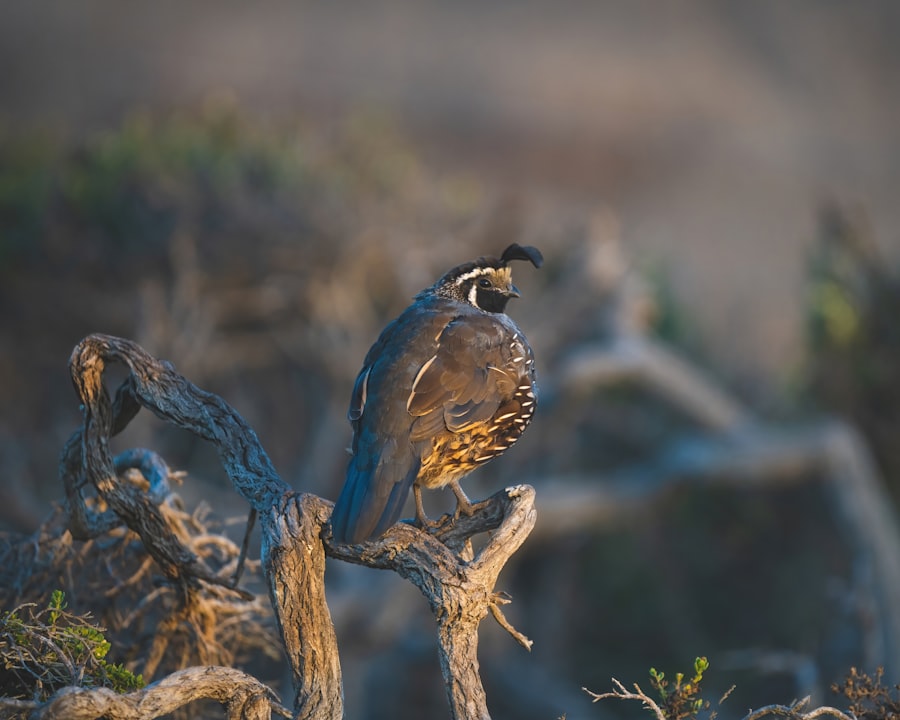
Health and disease management is an important aspect of bobwhite quail conservation and management. These birds are susceptible to a variety of diseases and health issues that can impact their overall population health. It’s important to implement effective health management strategies to monitor for diseases, prevent outbreaks, and minimize their impact on bobwhite quail populations.
One way to manage health and disease in bobwhite quail is by monitoring population health through regular surveys and observations. This can help identify any signs of disease or health issues in the population so that appropriate measures can be taken to address them. It’s also important to work with wildlife biologists or veterinarians to conduct disease testing and surveillance to monitor for any potential threats to the quail population.
In addition to monitoring population health, it’s important to implement biosecurity measures to prevent the introduction and spread of diseases in bobwhite quail populations. This includes controlling access to the property by people or pets that may carry diseases, as well as implementing sanitation measures to reduce the risk of disease transmission within the population.
Overall, managing health and disease in bobwhite quail populations requires proactive monitoring, disease testing, biosecurity measures, and collaboration with wildlife professionals to ensure the long-term health and sustainability of these iconic birds.
Hunting and Conservation of Bobwhite Quail
Hunting plays a significant role in the conservation of bobwhite quail populations. Managed hunting programs can help regulate population numbers, reduce competition for resources, and promote healthy population dynamics among bobwhite quail. However, it’s important to implement sustainable hunting practices that support conservation efforts while also providing recreational opportunities for hunters.
One way to support sustainable hunting of bobwhite quail is by implementing harvest management strategies that regulate hunting pressure based on population size and reproductive success. This can help prevent overharvesting of quail populations while also ensuring that hunting opportunities are available for enthusiasts.
In addition to harvest management, it’s important to create habitat management programs that support healthy bobwhite quail populations while also providing suitable hunting opportunities. This includes maintaining open grasslands with scattered shrubs and trees that provide suitable cover for the birds while also allowing hunters access to hunting areas.
Overall, hunting plays a crucial role in the conservation of bobwhite quail populations when managed sustainably. By implementing harvest management strategies and supporting habitat management programs that benefit both the birds and hunters, conservation efforts can be enhanced while also providing recreational opportunities for hunting enthusiasts.
If you’re interested in keeping bobwhite quail, you may also want to consider converting a shed into a quail coop. This related article on PoultryWizard provides valuable insights into turning a shed into a chicken coop, which can be adapted for housing quail as well. Check out the article here for practical tips on creating a suitable habitat for your quail.
FAQs
What is the habitat of bobwhite quail?
Bobwhite quail prefer open grasslands, agricultural fields, and brushy areas with scattered shrubs. They also thrive in areas with a mix of grasses, forbs, and woody cover.
What do bobwhite quail eat?
Bobwhite quail primarily feed on seeds, grains, and insects. Their diet may also include fruits, leaves, and small invertebrates.
How do you attract bobwhite quail to your property?
To attract bobwhite quail, provide a mix of open grassy areas, brushy cover, and food sources such as native grasses, forbs, and shrubs. Creating a diverse habitat with suitable nesting and brood-rearing areas can also help attract and support bobwhite quail populations.
What are the threats to bobwhite quail populations?
Threats to bobwhite quail populations include habitat loss and fragmentation, predation, pesticide use, and changes in land management practices. Additionally, severe weather events and disease outbreaks can impact bobwhite quail populations.
How can landowners help conserve bobwhite quail?
Landowners can help conserve bobwhite quail by implementing habitat management practices such as prescribed burning, native grassland restoration, and brush management. Creating and maintaining suitable habitat for nesting, brood-rearing, and winter cover can also support bobwhite quail populations.
Meet Walter, the feathered-friend fanatic of Florida! Nestled in the sunshine state, Walter struts through life with his feathered companions, clucking his way to happiness. With a coop that’s fancier than a five-star hotel, he’s the Don Juan of the chicken world. When he’s not teaching his hens to do the cha-cha, you’ll find him in a heated debate with his prized rooster, Sir Clucks-a-Lot. Walter’s poultry passion is no yolk; he’s the sunny-side-up guy you never knew you needed in your flock of friends!

